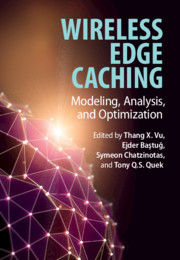Book contents
- Frontmatter
- Contents
- List of Contributors
- Preface
- 1 Introduction
- Part I Optimal Cache Placement and Delivery
- 2 Coded Caching for Heterogeneous Wireless Networks
- 3 Wireless Device-to-Device Caching Networks
- 4 Cooperative Caching in Cloud-Assisted 5G Wireless Networks
- 5 Stochastic Caching Schemes in Large Wireless Networks
- 6 Joint Policies for Caching, Routing, and Channel Selection in Next-Generation Wireless Edge Systems
- Part II Proactive Caching
- Part III Cache-Aided Interference and Physical Layer Management
- Part IV Energy-Efficiency, Security, Economic, and Deployment
- Index
4 - Cooperative Caching in Cloud-Assisted 5G Wireless Networks
from Part I - Optimal Cache Placement and Delivery
Published online by Cambridge University Press: 19 October 2020
- Frontmatter
- Contents
- List of Contributors
- Preface
- 1 Introduction
- Part I Optimal Cache Placement and Delivery
- 2 Coded Caching for Heterogeneous Wireless Networks
- 3 Wireless Device-to-Device Caching Networks
- 4 Cooperative Caching in Cloud-Assisted 5G Wireless Networks
- 5 Stochastic Caching Schemes in Large Wireless Networks
- 6 Joint Policies for Caching, Routing, and Channel Selection in Next-Generation Wireless Edge Systems
- Part II Proactive Caching
- Part III Cache-Aided Interference and Physical Layer Management
- Part IV Energy-Efficiency, Security, Economic, and Deployment
- Index
Summary
Cloud-assisted wireless networks are emerging solutions that unite wireless networks and cloud computing to deliver cloud services directly from the network edges to support the foreseen massive demands from data- and computation-hungry mobile users. In this chapter, we first provide an overview of the two emerging cloud-assisted wireless network paradigms – namely, the cloud radio access network (C-RAN), which aims at centralization of base station (BS) functionalities, and mobile-edge computing (MEC), which aims at providing the RAN with computing and storage resources. We then leverage the C-RAN and MEC paradigms to design novel cooperative caching frameworks that explore the synergies of the in-network computing and storage resources. Specifically, a novel cooperative hierarchical caching framework is designed in C-RAN, where caching is performed both at the distributed BSs and at the cloud processing unit (CPU), which bridges the gap between the traditional edge-based and core-based caching schemes. Furthermore, a joint cooperative caching and processing framework is designed in a MEC network, where the MEC servers perform both cache storage and video transcoding to support adaptive bitrate (ABR) video streaming.
- Type
- Chapter
- Information
- Wireless Edge CachingModeling, Analysis, and Optimization, pp. 66 - 88Publisher: Cambridge University PressPrint publication year: 2021

